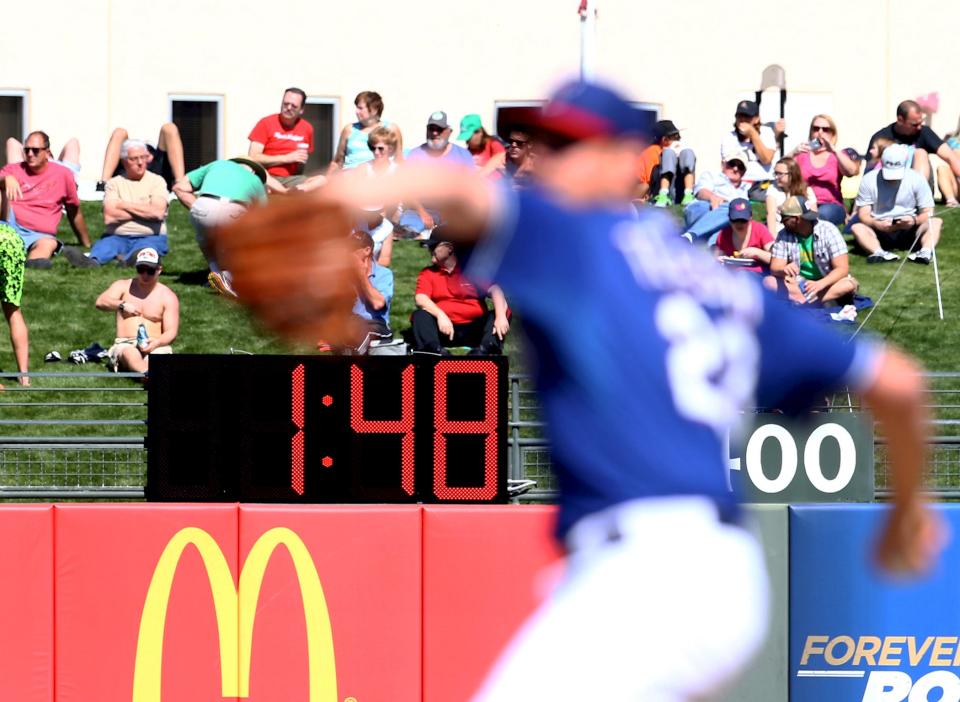MLB's plan on how they can make baseball games at least 10 minutes shorter

Major League Baseball plans to implement a pitch clock and stricter rules on mound visits in the 2018 season, according to a memo obtained by Yahoo Sports that outlines the changes, with the MLB Players Association expected to reject an agreement the league offered.
After the MLBPA declined a similar proposal last year, the league threatened to unilaterally impose a timer between pitches, batters and innings, as well severely limit mound visits without the union’s consent, as is its right. The average time of game swelled to a record 3 hours, 8 minutes last season. Officials believe a pitch clock can shave at least 10 minutes off game time.
The negotiations between the sides come at a precarious time in labor relations, as the frozen free-agent market has angered players and emboldened them to turn down a proposal with several concessions in their favor but not enough to reach an agreement. The plan for the union to reject the changes first was reported by The Athletic.
MLB intends to use a 20-second pitch clock with the bases empty and runners on, according to the memo. In the proposed agreement, the pitch clock would have been 18 seconds with the bases empty and would have been shut off with runners on. The clock will start when a pitcher has the ball on the mound and stop when the pitcher begins his windup or comes set. If the pitcher steps off the rubber, the clock resets. Batters must be in the box five seconds after the clock starts.
Should a pitcher run afoul of the rule, he will receive one warning per game. The next violation would result in an automatic ball. The penalty will begin on opening day, as opposed to the rejected proposal, which would’ve delayed the implementation until May 1.
The restrictions on mound visits are particularly acute. Any time a coach, manager or player visits a pitcher on the mound, or a pitcher leaves the mound to confer with a player, it counts as a visit. Upon the second visit to the pitcher in the same inning, he must exit the game. Under the proposal, each team would have received six so-called “no-change” visits that would have prevented the pitcher from leaving the game.
In addition, there will be a 30-second between-batters timer implemented starting opening day. Each hitter will receive one warning per game. Part of the rejected proposal includes expanding that timer to 35 seconds.
Should the union officially reject the plan, MLB intends in 2019 to make inning breaks 2 minutes, 20 seconds for local games and 2:40 for national games, according to the memo, and to institute a six-pitch maximum for warm-ups that must be finished with 35 seconds left on the between-innings clock. The amount of commercial time the league sells would remain 90 seconds, according to a source, giving players ample time to prepare for the next half-inning.
Baseball first tested a pitch clock in the Arizona Fall League in 2014, then expanded its use to Double-A and Triple-A the next season. The leagues saw enough improvement in average game time for MLB to justify its push, even at the expense of souring already-troublesome relations with the MLBPA.
More from Yahoo Sports:
• Wetzel: Sexual molester Larry Nassar played the victim in court
• The heat on Seelers coach Mike Tomlin is justified … to a point
• Kris Dunn busts teeth in scary post-dunk fall
• Landon Donovan un-retiring again is so Landon Donovan
• Mel Kiper has Josh Allen going No. 1


